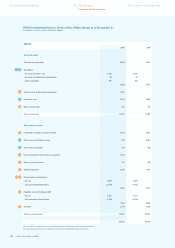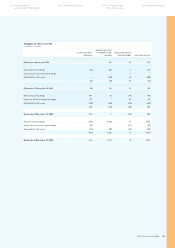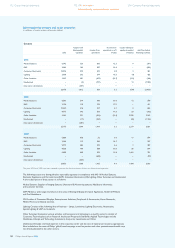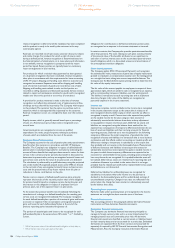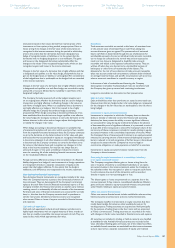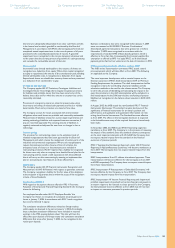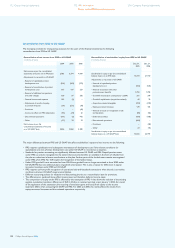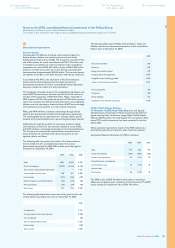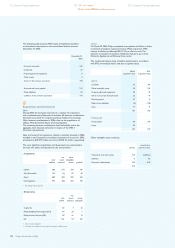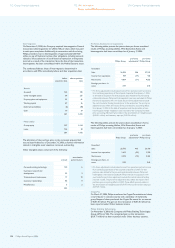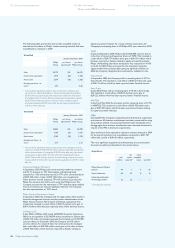Philips 2006 Annual Report Download - page 186
Download and view the complete annual report
Please find page 186 of the 2006 Philips annual report below. You can navigate through the pages in the report by either clicking on the pages listed below, or by using the keyword search tool below to find specific information within the annual report.
Philips Annual Report 2006186
revenue recognition is deferred until the installation has been completed
and the product is ready to be used by the customer in the way
contractually agreed.
Revenues are recorded net of sales taxes, customer discounts, rebates
and similar charges. For products for which a right of return exists
during a defi ned period, revenue recognition is determined based on
the historical pattern of actual returns, or in cases where such information
is not available, revenue recognition is postponed until the return
period has lapsed. Return policies are typically based on customary
return arrangements in local markets.
For products for which a residual value guarantee has been granted
or a buy-back arrangement has been concluded, revenue recognition
takes place in accordance with the requirements for lease accounting
of IAS 17 ‘Leases’. Shipping and handling costs billed to customers are
recognized as revenues. Expenses incurred for shipping and handling
costs of internal movements of goods are recorded as cost of sales.
Shipping and handling costs related to sales to third parties are
recorded as selling expenses and disclosed separately. Service revenue
related to repair and maintenance activities for goods sold is recognized
ratably over the service period or as services are rendered.
A provision for product warranty is made at the time of revenue
recognition and refl ects the estimated costs of replacement and free-
of-charge services that will be incurred by The Company with respect
to the products The customer has the option to purchase such an
extension, which is subsequently billed separately to the customer.
Revenue recognition occurs on a straight-line basis over the contract
period.
Royalty income, which is generally earned based upon a percentage
of sales or a fi xed amount per product sold, is recognized on an
accrual basis.
Government grants are recognized as income as qualifi ed
expenditures are made, except for grants relating to purchases
of assets, which are deducted from the cost of the assets.
Employee Benefi t Accounting
The Company accounts for the cost of pension plans and postretirement
benefi ts other than pensions in accordance with IAS 19 ‘Employee
Benefi ts’. The Company’s net obligation in respect of defi ned-benefi t
pension plans is calculated separately for each plan by estimating the
amount of future benefi t that employees have earned in return for their
service in the current and prior periods; that benefi t is discounted to
determine its present value, and any unrecognized actuarial losses and
past service costs and the fair value of any plan assets are deducted.
The calculation is performed by a qualifi ed actuary using the projected
unit credit method. Recognized prepaid assets under IFRS are limited
to the net total of any unrecognized actuarial losses and past service
costs and the present value of any future refunds from the plan or
reductions in future contributions to the plan.
Pension costs in respect of defi ned-benefi t pension plans primarily
represent the increase of the actuarial present value of the obligation
for pension benefi ts based on employee service during the year and
the interest on this obligation in respect of employee service in
previous years, net of the expected return on plan assets.
To the extent that pension benefi ts vest immediately following the
introduction of a change to a defi ned-benefi t plan, the resulting past
service costs are recognized immediately. The Company recognizes
for each defi ned-benefi t plan a portion of its actuarial gains and losses
as income or expense if the net cumulative unrecognized actuarial
gains and losses for each defi ned-benefi t plan at the end of the
previous reporting period exceeded the greater of:
The portion of actuarial gains and losses to be recognized for each
defi ned-benefi t plan is the excess above 10% under 1) or 2) divided by
5 years.
Obligations for contributions to defi ned-contribution pension plans
are recognized as an expense in the income statement as incurred.
In certain countries, the Company also provides postretirement benefi ts
other than pensions. The costs relating to such plans consist primarily
of the present value of the benefi ts attributed on an equal basis to
each year of service, interest cost on the accumulated postretirement
benefi t obligation, which is a discounted amount, and amortization of
the unrecognized transition obligation.
Share-based payment
The Company applies IFRS 2 ‘Share-based Payments’ and recognizes
the estimated fair value, measured as of grant date of equity instruments
granted to employees as compensation expense over the vesting period
on a straight-line basis, taking into account expected forfeitures. The
Company uses the Black-Scholes option-pricing model to determine the
fair value of the equity instruments.
The fair value of the amount payable to employees in respect of share
appreciation rights, which are settled in cash, is recognized as an expense,
with a corresponding increase in liabilities, over the vesting period.
The liability is remeasured at each reporting date and at settlement
date. Any changes in fair value of the liability are recognized as
personnel expense in the income statement.
Income tax
Income tax comprises current and deferred tax. Income tax is recognized
in the income statement except to the extent that it relates to an
item recognized directly within equity, in which case the tax effect is
recognized in equity as well. Current tax is the expected tax payable
on the taxable income for the year, using tax rates enacted or
substantially enacted at the balance sheet date, and any adjustment
to tax payable in respect of previous years. Deferred tax assets and
liabilities are recognized, using the balance sheet method, for the
expected tax consequences of temporary differences between the tax
base of assets and liabilities and their carrying amounts for fi nancial
reporting purposes. Deferred tax is not recognized for the following
temporary differences: the initial recognition of goodwill, the initial
recognition of assets and liabilities in a transaction that is not a business
combination and that affects neither accounting nor taxable profi t, and
differences relating to investments in subsidiaries to the extent that
they probably will not reverse in the foreseeable future. Measurement
of deferred tax assets and liabilities is based upon the enacted or
substantially enacted tax rates expected to apply to taxable income in
the years in which those temporary differences are expected to be
recovered or settled. Deferred tax assets, including assets arising from
loss carry-forwards, are recognized if it is probable that the asset will
be realized. Deferred tax assets are reviewed each reporting date and
a valuation allowance is provided to the extent that it is no longer
probable that the related tax benefi t will be realized. Deferred tax assets
and liabilities are not discounted.
Deferred tax liabilities for withholding taxes are recognized for
subsidiaries in situations where the income is to be paid out as
dividend in the foreseeable future, and for undistributed earnings of
unconsolidated companies. Changes in tax rates are refl ected in the
period when the change has been enacted or substantively enacted
by the balance sheet date.
Operating lease payments
Payments made under operating leases are recognized in the income
statement on a straight-line basis over the term of the lease.
Financial instruments
The accounting policies in this paragraph address Derivative fi nancial
instruments and Non-derivative fi nancial instruments.
Derivative fi nancial instruments
The Company uses derivative fi nancial instruments principally to
manage its foreign currency risks and to a more limited extent for
managing interest rate and commodity price risks. All derivative
fi nancial instruments are classifi ed as current assets or liabilities based
on their maturity dates and are accounted for at trade date. Embedded
derivatives are separated from the host contract and accounted for
separately if required by IAS 39 ‘Financial Instruments: Recognition and
Measurement’. Also, the Company measures all derivative fi nancial
1) 10% of the present value of the defi ned-benefi t obligation at that date; or,
2) 10% of the fair value of any plan asset at that date.
112 Group fi nancial statements 172 IFRS information
IFRS accounting policies
218 Company fi nancial statements


